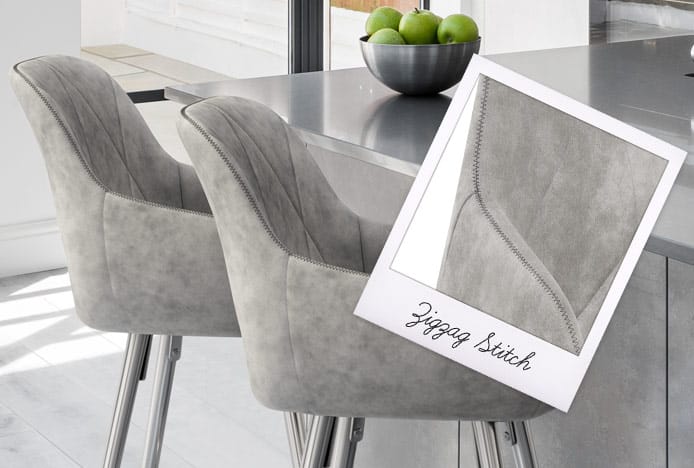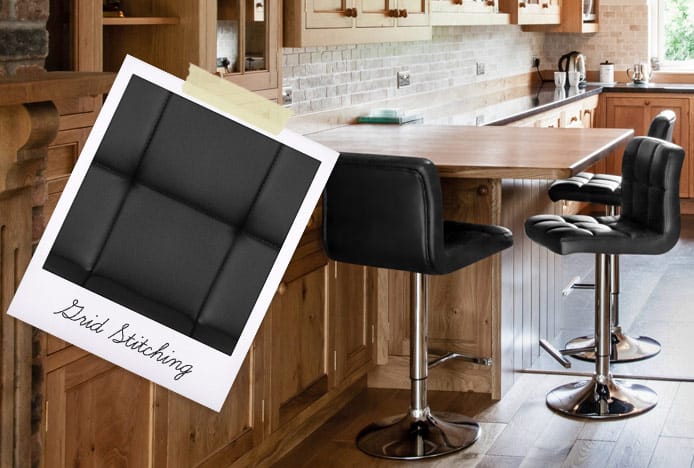The Use of Stitching in Furniture
By Sophie Hardy, 20th December, 2018
Stitching in furniture is mostly used to serve the functional purpose of joining the upholstery together, but there is more to it than you think. It’s often something we take for granted, but it is surprising how many different techniques and styles there are when you take a closer look. It can be a way of accentuating the lines and curves of an upholstered item, and decorative designs can also be sewn into furniture to create attention-grabbing detail.
In this article we will take you through the different types of stitching we use in our products, along with the different patterns that can be created.

We will be using a few technical terms in this article, these are explained below:
Stitch – a stitch is the result of using a needle and thread in an in-and-out movement on a piece of material
Seam – a type of stitch with the sole purpose of connecting two pieces of material
Right side – the right side of the material is the front, or the side that will be seen on the outside when the sewing is complete.
Wrong side – the wrong side of the material is the back, or the side that will be hidden on the inside when the sewing is complete.
Seam allowance – the seam allowance is the space left between the seam and the edge of the material.
Seam finish – a seam finish is a way of sewing the seam allowance to reduce the chance of fraying and to add durability.
Types of Stitching
We use various types of stitching in our dining chairs and bar stools, some of which are purely functional whilst others also have a decorative purpose. The different types we use are outlined below:
1. Plain Seam
Whilst a seam is technically a stitch, the term is specifically used for a stitch that is used to join two pieces of material. For that reason, it is one of the most common types of stitching and is found on most of our upholstered products. Due to the stitch being sewn with the right sides of the materials facing each other, you will only ever see a neat single line because the seam allowance is concealed on the wrong side of the material.
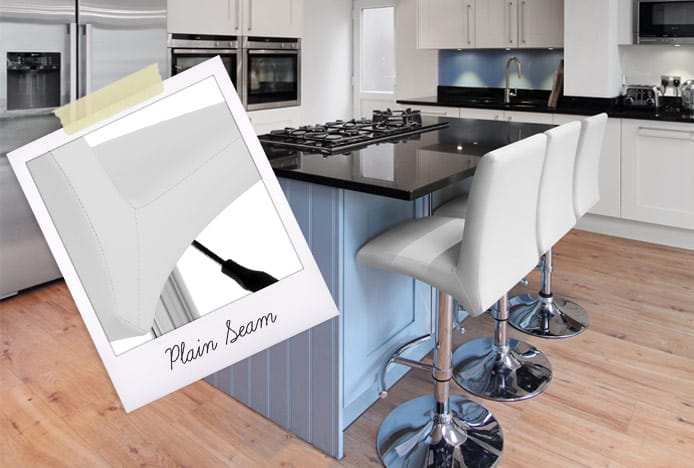
2. Top Stitched Seam
A top stitch is a line of stitching designed to be seen on the right side of the material and is either used for decorative purposes or for added strength. In our furniture, a top stitch is often sewn alongside a plain seam, as seen below. This strengthens the seam by sewing through the seam allowance on the underside, which secures it in place. It can also be used to create different patterns, as we demonstrate further on in this article.

Lush Brushed Steel Bar Stool Black
3. Double Top Stitched Seam
Some of our products may have a double top stitched seam. This is where a top stitch is sewn on either side of a plain seam. Not only does this reinforce the design further, it can also add a decorative look with some designs, like the Lancaster, using a contrasting colour to make it a feature.

Lancaster Dining Chair Grey Fabric
4. Zigzag Stitch
A zigzag stitch is sturdier than other straight stitches, and so it is ideal for designs that need to be held tight. It is often used as a seam finish for reinforcement, or over the top of a plain seam in a contrasting colour for a decorative pattern. You can see an example of this in the Fusion Chair below.
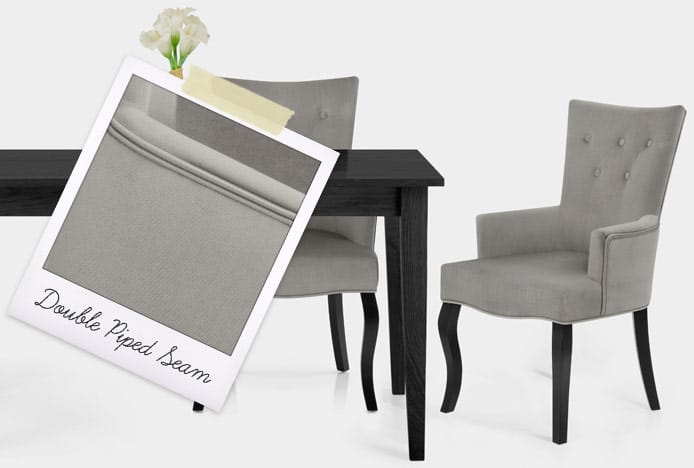
Patterns & Designs Created With Stitching
Different types of stitching can be used to create patterns in upholstery. This is the more decorative style that will catch your eye and create a focal point in your furniture.
1. Tufting
Typically used on traditional upholstered furniture, tufting is the deep buttoned detailing often found on the backrests of chairs and sofas. Tufting was originally used to stop the padding from shifting inside the upholstery and becoming misshaped. It therefore gives a sense of classic comfort and luxury.
To create the distinct look, a button is attached to a thread that is pulled tight through the upholstery and attached to the frame at the back of the seat. This creates pleats and dimples, and the raised areas that surround the dimples are known as the tufts. Sometimes, stitching is used to create the pleated look and this is common with materials that are too thick to fold. We use three types of tufting in our products, these are detailed below:
Diamond Tufting
The most recognisable type of tufting is diamond tufting. This is where the buttons are positioned so that the pleats create a diamond pattern, seen on the Barrington below. Our Knightsbridge Oak Chair has a half diamond pattern, where the pleats extend to the edge of the seat instead of making a full diamond.
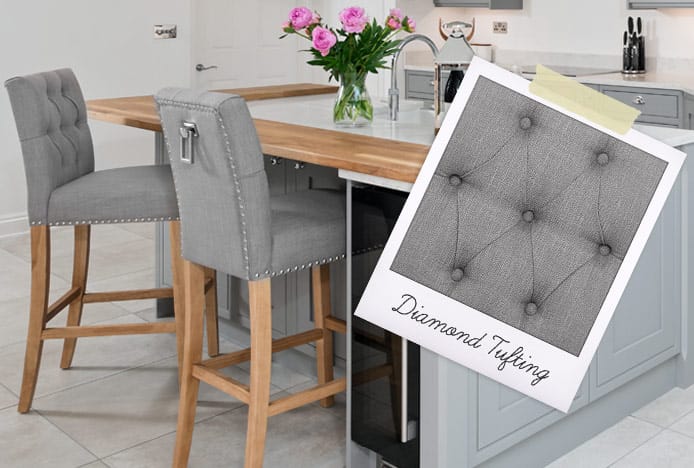
Biscuit Tufting
Biscuit tufting looks as good as it sounds, and is a modern take on the traditional design. The buttons are positioned in uniform rows to create a linear grid pattern with the pleats between each button. The Dove Bar Stool demonstrates this in the image below, and our Carlton Bar Stool also features biscuit tufting.
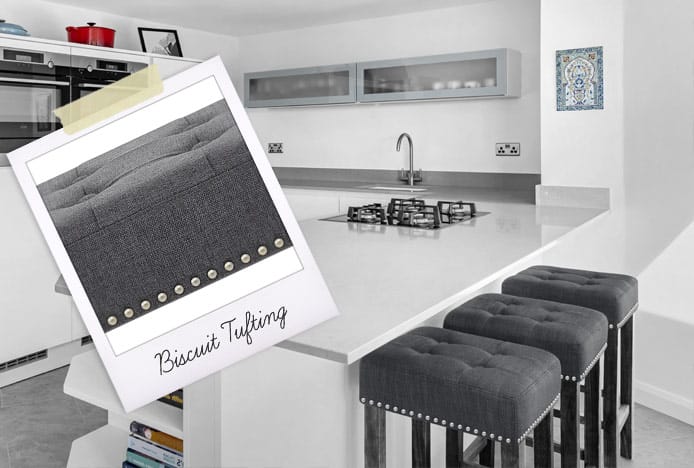
Dove Bar Stool Charcoal Fabric
Blind Tufting
Tufting can also be done without buttons, and this is known as blind tufting. It’s the same process, except the thread is pulled through on its own to create the classic dimple and is secured with a knot rather than a button. This style of tufting is a subtle approach and is found on more modern furniture.

2. Diamond Quilting
A design often associated with jackets or car interiors, diamond quilting is becoming increasingly popular in dining chairs and bar stools. A diamond pattern is created in the upholstery with rows of top stitch lines crossing over in opposite directions. We use diamond quilting in the Lux Dining Chair, adding a classic look to a modern design.
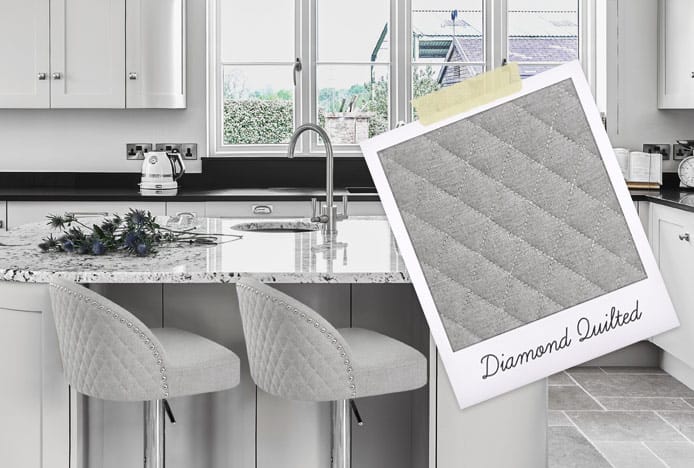
3. Vertical or Horizontal Segments
We have many designs where vertical or horizontal stitch lines are used to create a linear segmented pattern. The foam padding beneath the seat is shaped into linear sections, allowing the upholstery and stitching to be pulled into them. This creates a comfortable cushioned look with deep panels. Another method is to use the same process on a thinner piece of foam on top of the regular foam padding, creating a design with shallow panels.
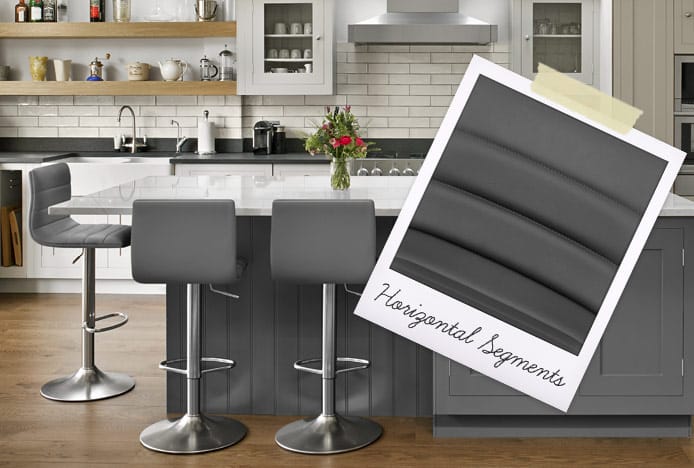
Linear Brushed Steel Bar Stool Grey
4. Grid Stitching
A grid pattern can also be produced using the same method as the vertical and horizontal segments. Single top stitch lines are sewn in a quilt-like pattern, and this tends to be popular on modern designs, such as the aptly named Grid Bar Stool in the image below. Our Criss Cross Bar Stool also features the grid pattern with a stylish double top stitch.
Most of us don’t take the time to appreciate stitching in furniture, but it can take a lot of time and effort to create certain styles, and this may be reflected in the price of more elaborate designs. Each type creates a different visual aesthetic, but it depends on individual taste as to whether you opt for a subtle design with functional stitching or a highly detailed statement piece.
Recommended Articles
Return of Fabric to Stools & Chairs
By popular demand, we're introducing more fabric covered stools to our range..
Velvet Care Guide
Keep your velvet furniture looking as good as new with our velvet care guide..
How to Use Velvet in the Home
Velvet is the must-have material this season. Get this luxury look in your home..
Recent Popular Posts
3 Easy Steps to Scandinavian Style in Your Home
Featuring natural materials, clean lines and light spaces, Scandi style is clean and cosy..
6 Ways to Use Texture in Your Kitchen
Six easy ways that you can use texture to liven up your kitchen design..
How to Brighten up a Dark Kitchen
Whether your kitchen's a small space, or just poorly lit, brighten it up in 5 steps..
How to Create a Cosy Corner in Your Home
Staying in is the new going out! Pop the kettle on and relax in a cosy corner..




















